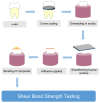Shear Bond Strength and Fluoride Release of a Universal Adhesive: An In-Vitro Study on Primary Teeth
- PMID: 37048867
- PMCID: PMC10095296
- DOI: 10.3390/ma16072573
Shear Bond Strength and Fluoride Release of a Universal Adhesive: An In-Vitro Study on Primary Teeth
Abstract
This investigation aimed to assess the shear bond strength and fluoride-releasing capabilities of Clearfil Universal Bond Quick (Kuraray Noritake Dental Inc., Tokyo, Japan). Forty-four extracted primary molars were divided into two groups, and the enamel substrate was prepared for evaluating shear bond strength. Scotchbond (3M ESPE) and Clearfil UBQ were used to bond composite-to-enamel substrates in each group (n = 22). Shear bond strength was measured using a universal testing device and compared. Sixteen discs (6 mm diameter and 3 mm thickness) were fabricated from each Clearfil UBQ, Fuji IX, and Fuji II LC. Over the course of 30 days, each materials' fluoride release was examined and compared using ion analysis. Results revealed that Clearfil UBQ had statistically similar shear bond strength to Scotchbond. Between the three materials, Clearfil UBQ had the lowest fluoride release at baseline (0.11 ± 0.25) and the lowest cumulative fluoride release (0.12-0.27 ppm) over 30 days. Fuji IX had the highest fluoride release at baseline (19.38 ± 2.50) and cumulatively (40.87 ± 4.03 ppm), followed by Fuji II LC. We conclude that Clearfil UBQ and Scotchbond showed comparable bond strengths to the enamel. Fluoride release was seen in Clearfil UBQ in the initial two days of the 30-day period. The amount of fluoride release was significantly less than with glass ionomer cements.
Keywords: Clearfil UBQ; Scotchbond; fluoride release; glass ionomer; primary teeth; shear bond strength; universal adhesive.
Conflict of interest statement
The authors declare no conflict of interest.
Figures
Similar articles
-
Shear bond strength of composite, glass ionomer, and acidic primer adhesive systems.Am J Orthod Dentofacial Orthop. 1999 Jan;115(1):24-8. doi: 10.1016/s0889-5406(99)70312-4. Am J Orthod Dentofacial Orthop. 1999. PMID: 9878954
-
Comparative evaluation of shear bond strength and microleakage of tricalcium silicate-based restorative material and radioopaque posterior glass ionomer restorative cement in primary and permanent teeth: an in vitro study.J Indian Soc Pedod Prev Dent. 2014 Oct-Dec;32(4):304-10. doi: 10.4103/0970-4388.140952. J Indian Soc Pedod Prev Dent. 2014. PMID: 25231038
-
Quick bonding using a universal adhesive.Clin Oral Investig. 2020 Aug;24(8):2837-2851. doi: 10.1007/s00784-019-03149-8. Epub 2019 Dec 7. Clin Oral Investig. 2020. PMID: 31813057
-
Comparison of enamel bond fatigue durability of universal adhesives and two-step self-etch adhesives in self-etch mode.Am J Dent. 2017 Oct;30(5):279-284. Am J Dent. 2017. PMID: 29178732
-
Microshear Bond Strength of Different Adhesive Systems to Dentin.Front Dent. 2019 Jul-Aug;16(4):265-271. doi: 10.18502/fid.v16i4.2085. Epub 2019 Aug 30. Front Dent. 2019. PMID: 32342055 Free PMC article.
Cited by
-
Effect of Antibacterial Agents on Dentin Bond Strength of Bioactive Restorative Materials.Polymers (Basel). 2023 Jun 8;15(12):2612. doi: 10.3390/polym15122612. Polymers (Basel). 2023. PMID: 37376257 Free PMC article.
References
-
- GBD Collaborators Global, regional, and national incidence, prevalence, and years lived with disability for 354 diseases and injuries for 195 countries and territories, 1990–2017: A systematic analysis for the Global Burden of Disease Study 2017. Lancet. 2018;392:1789–1858. doi: 10.1016/S0140-6736(18)32279-7. - DOI - PMC - PubMed
LinkOut - more resources
Full Text Sources




